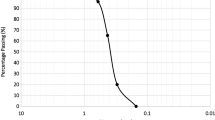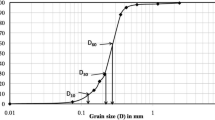Abstract
Biogrouting is a new ground improvement method that has been studied in recent years. This method involves mainly the use of a microbially induced calcite precipitation process to bind soil particles to increase the strength or to fill in the pores of soil or joints of rock for seepage control. There are two major challenges in the use of biogrout for seepage control through rock joints. The first is how to inject the biogrout solutions, and the second is to understand the mechanisms for the formation of calcite under seepage flow. In this paper, a study on the injection of biogrout solution and the formation of precipitates along a circular 1D flow channel is presented. To minimize the influence of flow, a new one-phase injection method to inject bacterial solution and cementation agents simultaneously was adopted in this study. Factors affecting the formation and distribution of precipitates along the flow channel such as flow velocity, flow rate, and aperture of flow channel were investigated. The experimental results indicated that less calcite was precipitated at locations further away from the injection point due to depletion of the reactants’ concentrations along the flow path. Using the one-phase injection method, the bacterial activity had a major effect on the accumulation of the calcite on the inner surface of the flow channel. The total calcite precipitated on the surface of the flow channel increased slightly with increasing bacterial activity or flow rate. An equation to predict the distance travelled by the biosolution has been derived based on the testing results.









Similar content being viewed by others
References
Akbari M, Sinton D, Bahrami M (2011) Viscous flow in variable cross-section microchannels of arbitrary shapes. Int J Heat Mass Transf 54(17–18):3970–3978
Carman PC (1997) Fluid flow through granular beds. Chem Eng Res Des 75:S32–S48
Cheng L, Qian C, Wang R, Wang J (2008) Bioremediation process of Cd2+ removal from soil by bacteria A biomineralization. Kuei Suan Jen Hsueh Pao/J Chin Ceram Soc 36(SUPPL):215–221
Cheng L, Cord-Ruwisch R, Shahin MA (2013) Cementation of sand soil by microbially induced calcite precipitation at various degrees of saturation. Can Geotech J 50(1):81–90
Choi SG, Park SS, Wu S, Chu J (2017) Methods for calcium carbonate content measurement of biocemented soils. J Mater Civ Eng 29(11):06017015
Chu J, Stabnikov V, Ivanov V (2012) Microbially induced calcium carbonate precipitation on surface or in the bulk of soil. Geomicrobiol J 29(6):544–549
Cuthbert MO, McMillan LA, Handley-Sidhu S, Riley MS, Tobler DJ, Phoenix VR (2013) A field and modeling study of fractured rock permeability reduction using microbially induced calcite precipitation. Environ Sci Technol 47(23):13637–13643
De Muynck W, De Belie N, Verstraete W (2010) Microbial carbonate precipitation in construction materials: a review. Ecol Eng 36(2):118–136
DeJong JT, Fritzges MB, Nüsslein K (2006) Microbially induced cementation to control sand response to undrained shear. J Geotech Geoenviron Eng 132(11):1381–1392
Dejong JT, Soga K, Kavazanjian E, Burns S, Van Paassen LA, Al Qabany A, Aydilek A, Bang SS, Burbank M, Caslake LF, Chen CY, Cheng X, Chu J, Ciurli S, Esnault-Filet A, Fauriel S, Hamdan N, Hata T, Inagaki Y, Jefferis S, Kuo M, Laloui L, Larrahondo J, Manning DAC, Martinez B, Montoya BM, Nelson DC, Palomino A, Renforth P, Santamarina JC, Seagren EA, Tanyu B, Tsesarsky M, Weaver T (2013) Biogeochemical processes and geotechnical applications: progress, opportunities and challenges. Geotechnique 63(4):287
Droppo IG, Ross N, Skafel M, Liss SN (2007) Biostabilization of cohesive sediment beds in a freshwater wave-dominated environment. Limnol Oceanogr 52(2):577–589
Fujita Y, Taylor JL, Gresham TL, Delwiche ME, Colwell FS, McLing TL, Petzke LM, Smith RW (2008) Stimulation of microbial urea hydrolysis in groundwater to enhance calcite precipitation. Environ Sci Technol 42(8):3025–3032
Gargiulo G, Bradford S, Šimůnek J, Ustohal P, Vereecken H, Klumpp E (2007) Bacteria transport and deposition under unsaturated conditions: the role of the matrix grain size and the bacteria surface protein. J Contam Hydrol 92(3–4):255–273
Hammes F, Verstraete W (2002) Key roles of pH and calcium metabolism in microbial carbonate precipitation. Rev Environ Sci Biotechnol 1(1):3–7
Harkes MP, Van Paassen LA, Booster JL, Whiffin VS, van Loosdrecht MC (2010) Fixation and distribution of bacterial activity in sand to induce carbonate precipitation for ground reinforcement. Ecol Eng 36(2):112–117
He B, Wang LZ, Hong Y (2017) Field testing of one-way and two-way cyclic lateral responses of single and jet-grouting reinforced piles in soft clay. Acta Geotech 12(5):1–14
Hilgers C, Urai JL (2002) Experimental study of syntaxial vein growth during lateral fluid flow in transmitted light: first results. J Struct Geol 24(6–7):1029–1043
Holmqvist P, Lettinga MP, Buitenhuis J, Dhont JK (2005) Crystallization kinetics of colloidal spheres under stationary shear flow. Langmuir 21(24):10976–10982
Hommel J, Lauchnor E, Phillips A, Gerlach R, Cunningham AB, Helmig R, Ebigbo Anozie, Class H (2015) A revised model for microbially induced calcite precipitation: Improvements and new insights based on recent experiments. Water Resour Res 51(5):3695–3715
Hong Y, Ng CWW, Wang LZ (2015) Initiation and failure mechanism of base instability of excavations in clay triggered by hydraulic uplift. Can Geotech J 52(5):599–608
Ivanov V, Chu J (2008) Applications of microorganisms to geotechnical engineering for bioclogging and biocementation of soil in situ. Rev Environ Sci Bio/Technol 7(2):139–153
Johnson CP, Li X, Logan BE (1996) Settling velocities of fractal aggregates. Environ Sci Technol 30(6):1911–1918
Juniper SK, Martineu P, Sarrazin J, Gelinas Y (1995) Microbial-mineral floc associated with nascent hydrothermal activity on CoAxial Segment, Juan de Fuca Ridge. Geophys Res Lett 22(2):179–182
Minto JM, MacLachlan E, El Mountassir G, Lunn RJ (2016) Rock fracture grouting with microbially induced carbonate precipitation. Water Resour Res 52(11):8827–8844
Mitchell AC, Dideriksen K, Spangler LH, Cunningham AB, Gerlach R (2010) Microbially enhanced carbon capture and storage by mineral-trapping and solubility-trapping. Environ Sci Technol 44(13):5270–5276
Mountassir GE, Lunn RJ, Moir H, MacLachlan E (2014) Hydrodynamic coupling in microbially mediated fracture mineralization: formation of self-organized groundwater flow channels. Water Resour Res 50(1):1–16
Nollet S, Hilgers C, Urai JL (2006) Experimental study of polycrystal growth from an advecting supersaturated fluid in a model fracture. Geofluids 6(2):185–200
Phillips AJ, Lauchnor E, Eldring J, Esposito R, Mitchell AC, Gerlach R, Cunningham AB, Spangler LH, Spangler LH (2012) Potential CO2 leakage reduction through biofilm-induced calcium carbonate precipitation. Environ Sci Technol 47(1):142–149
Phillips AJ, Cunningham AB, Gerlach R, Hiebert R, Hwang C, Lomans BP, Westrich J, Mantilla C, Kirksey J, Esposito R, Spangler L (2016) Fracture sealing with microbially-induced calcium carbonate precipitation: a field study. Environ Sci Technol 50(7):4111–4117
Rijn LCV (1984) Sediment transport, part II: suspended load transport. J Hydraul Eng 110(11):1613–1641
Stoner DL, Watson SM, Stedtfeld RD, Meakin P, Griffel LK, Tyler TL, Pegram LM, Barnes JM, Deason VA (2005) Application of stereolithographic custom models for studying the impact of biofilms and mineral precipitation on fluid flow. Appl Environ Microbiol 71(12):8721–8728
Tobler DJ, Maclachlan E, Phoenix VR (2012) Microbially mediated plugging of porous media and the impact of differing injection strategies. Ecol Eng 42:270–278
Van Paassen LA (2009) Biogrout, ground improvement by microbial induced carbonate precipitation. Doctoral dissertation, TU Delft, Delft University of Technology
van Paassen LA, Ghose R, van der Linden TJ, van der Star WR, van Loosdrecht MC (2010) Quantifying biomediated ground improvement by ureolysis: large-scale biogrout experiment. J Geotech Geoenviron Eng 136(12):1721–1728
Wang JY, De Belie N, Verstraete W (2012) Diatomaceous earth as a protective vehicle for bacteria applied for self-healing concrete. J Ind Microbiol Biotechnol 39(4):567–577
Wang LZ, He B, Hong Y, Guo Z, Li LL (2015) Field tests of the lateral monotonic and cyclic performance of jet-grouting reinforced cast-in-place piles. J Geotech Geo-environ Eng ASCE 141(5):06015001
Whiffin VS, van Paassen LA, Harkes MP (2007) Microbial carbonate precipitation as a soil improvement technique. Geomicrobiol J 24(5):417–423
Yao KM, Habibian MT, Omelia CR (1971) Water and waste water filtration. Concepts and applications. Environ Sci Technol 5(11):1105–1112
Zhong L, Islam MR (1995, January) A new microbial plugging process and its impact on fracture remediation. In: SPE annual technical conference and exhibition. society of petroleum engineers
Acknowledgements
We would like to acknowledge that this study is supported by Grant No. SUL2013-1 by the Ministry of National Development, Singapore. We would also like to thank the anonymous reviewers for the good comments which helped in the improvement of this paper.
Author information
Authors and Affiliations
Corresponding author
Additional information
Publisher's Note
Springer Nature remains neutral with regard to jurisdictional claims in published maps and institutional affiliations.
Rights and permissions
About this article
Cite this article
Wu, C., Chu, J., Wu, S. et al. Microbially induced calcite precipitation along a circular flow channel under a constant flow condition. Acta Geotech. 14, 673–683 (2019). https://doi.org/10.1007/s11440-018-0747-1
Received:
Accepted:
Published:
Issue Date:
DOI: https://doi.org/10.1007/s11440-018-0747-1




